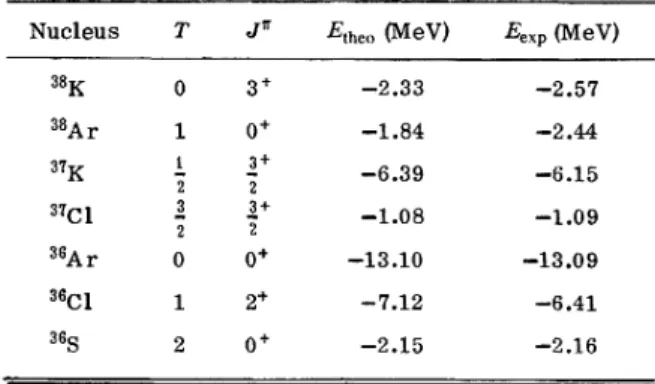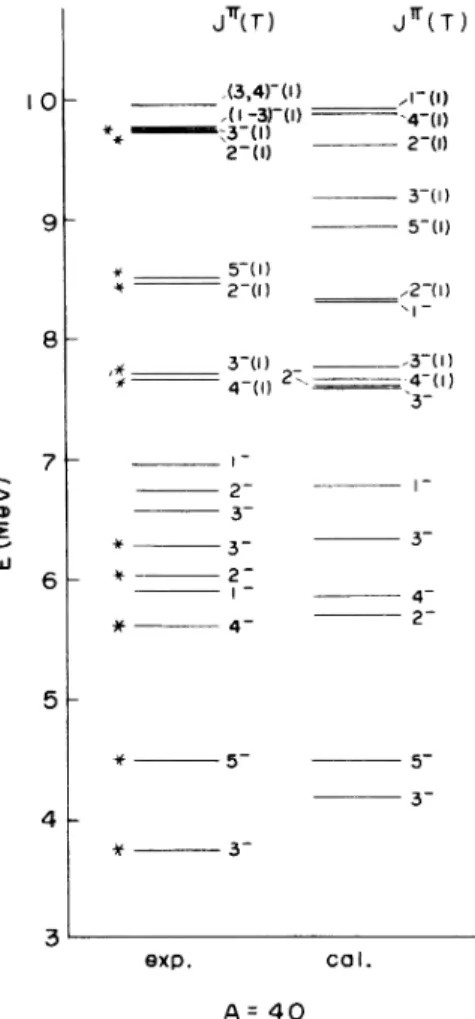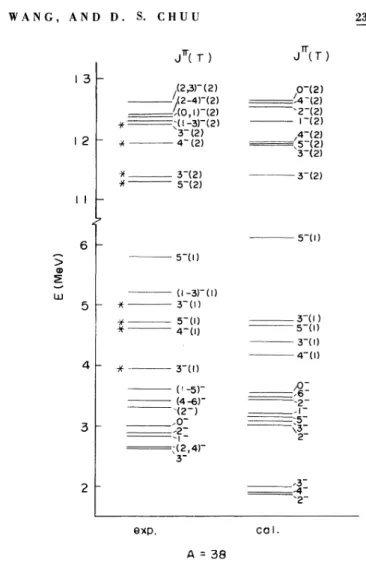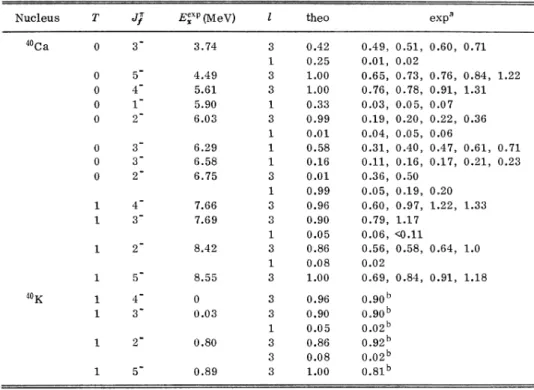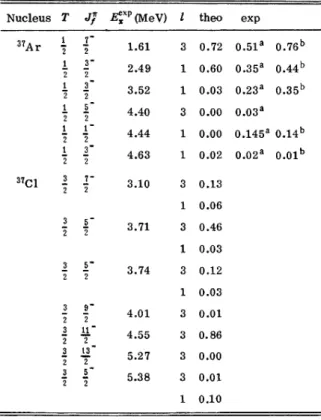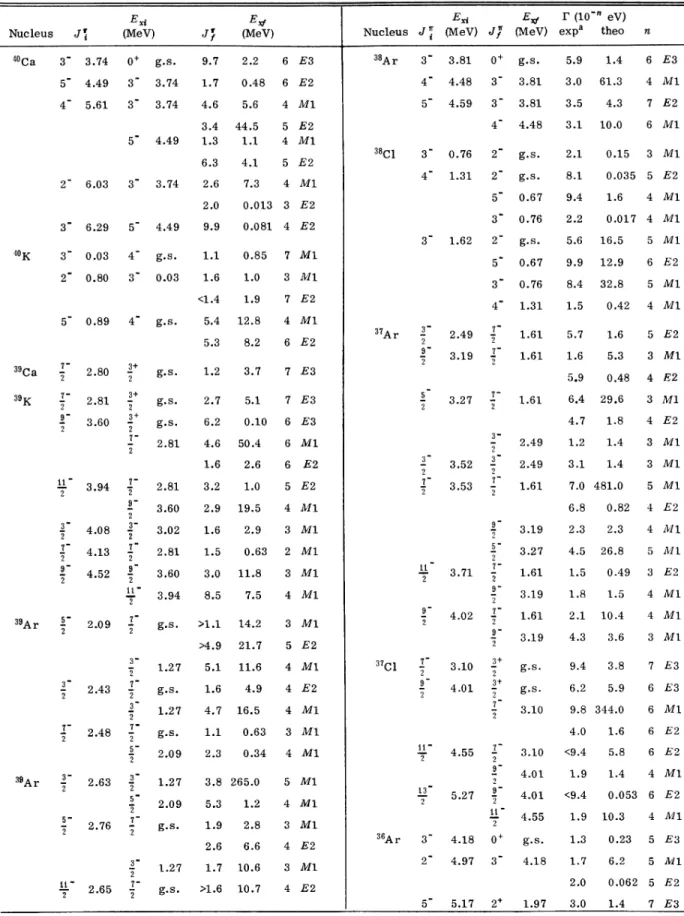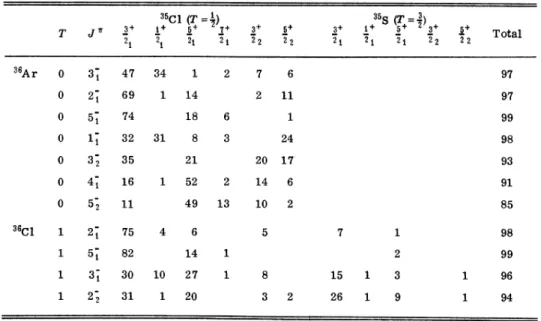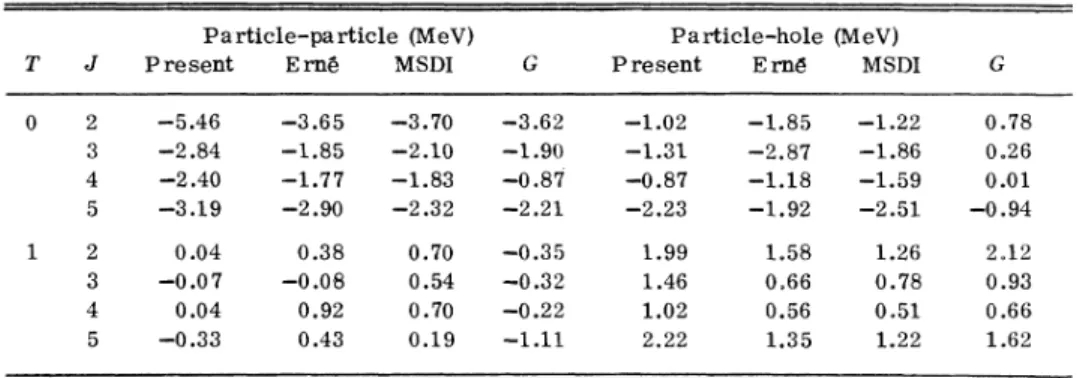PHYSICAL
REVIE%
C VOLUME23,
NUMBER 1 JANUARY1981
Calculations
on negative-parity
states
inthe nuclei
of
A=36
40
S.T.
Hsieh and M.C.WangDepartment ofPhysics, National TsingHua University, Taiu/an, Republic ofChina
D.
S.ChuuDepartment ofElectrophysics, National Chiao-Tung University, Hsinchu, Taiwan, Republic ofChina (Received 25June 1980j
A shell-model calculation ofthe negative-parity states in theA
=
36-40nuclei is presented. The nucleus "Cais assumed tobe an inert closed core. Active holes are restricted tothe (1d3/22$1/Qj configurations and an activeparticle is allowed tooccupy the 1f,/2or2p3/2orbit. Thetwo-body effective interaction is assumed tobe the modified
surface-delta type. Theenergy spectra are calculated from aleast-squares fittothe experimental data, varying the
T
=
0and T=
1strengths ofparticle-hole and hole-hole interactions and the three single-particle level splittings. Spectroscopic factors, E2,E3,and M1 transition rates, and two-body matrix elements are also calculated and compared with the observed values and the previous theoretical results. Thevalidity ofthe weak-coupling model is also tested.NUCLEAR STRUCTURE
4=36-40,
calculated effective interaction, energy spectra,spectroscopic factors and EM transition rates.
I. INTRODUCTION
For
negative-parity states in nuclei with massnumbers A
= 36-40,
only afew calculations havebeen performed. Most ofthese assumed an inert closed ~S
core
with configurationrestricted
towithin the (1d3/&, 1f&/,)or (ld3/g 2p3/2) space. In this paper, the nuclei with A
=
36-40
are
cal-culated within the framework of the shell model.
The nucleus Ca
is
assumed tobe an inertcore.
In actual calculations, holes
are
assumed tobedistributed in the 1d3/2 and
2s«,
orbitals and oneparticle in the 1f&/2 or 2p3/2 orbital. The
exten-sion of the model space
is
expected to obtain abet-ter
systematically theoretical prediction ofodd-parity states in this mass region.
The
earlier
examples of shell-model calculationson levels of odd parity in the region of the 1d3/2
shell nuclei were performed by Goldstein and
Tal-mi and Pandya with the
restriction
that onepro-ton
is
in the 1d3/g shell and one neutronis
in the lf&/2 shell. Erne extended their model space toinclude an arbitrary number of nucleons in the
Id3/2 shell with all inner shells considered an inert
S
core.
Twelve two-body interaction matrixele-ments of the
extra-core
nucleons and two bindingenergies to the
core
were treated asfree
parame-ters
tofit
sixty nuclear levels, includingeven-parity states belonging to configurations in the
1d3/g shell only, of nuclei in the range
S-
'Ca.
Under this severely
restricted
(ld~/2, 1f&/2)con-figuration, the agreements between the theoretical
and experimental odd-parity levels
are,
of course,only possible for the very lowest
states.
Maripuuand Hokken studied the nuclei ofA
=35,
37, and39with residual interaction in the form of a
modi-fied surface-delta interaction (MSDI). Taking into
account the configurations of
(1d3„,
1f„,
)and(ld3/2 2P3/2), great disagreement with the
experi-ment still
arose.
Neither the energies nor thelevel order ofthe identified states of some nuclei
could be reproduced well by his calculations.
Maripuu et
al.
calculated energies and wavefunc-tions for Cl, K, and Kin a model space which
included d&/&, s«&, d3/2, f&/&, and p3/2 orbitals. The two-body matrix elements used in their
Ham-iltonian were calculated from the Sussex relative
oscillator matrix elements with space truncation
effects added. In their calculation, the observed
anomalously large 32
-4&
M1 transition strength,which cannot be understood when only assuming a
weak-configuration mixing, thus can be
correctly
predicted. The odd-parity states of nuclei with
mass numbers A
=39-41
have also been studied byHsieh et
al.
6They included the complete 2s,1d
and
1f,
2P shells ina
first
order Tamm-Dancoffcalculation. The spectroscopic
factors
and EMtransition
rates
were obtained in reasonableagree-ment with the experimental data. Recently, Has-per' presented a shell-model calculation on
even-and odd-parity states of nuclei in the mass region
A
=36-39.
In spite ofhaving used about the samemodel space (the restriction of the number of
nu-cleons distributed in the
2s«2
and 1fv/-2are
differ-ent) as has been used in the present work, an inert
closed ~Si
core
was assumed in his work. In
ad-dition to this, only seventeen experimental levels
were included in his least-squares
fit.
However,the reliable experimental data available now
cer-tainly include much more than this value.
Fur-thermore, he did not calculate the spectroscopic
factors
and EM transition and thus thereis
no wayto determine how good the wave functions
are.
In this work, we calculate the negative-parity
states in A
=36-40
nuclei assuming the nucleusCa tobe an inert closed
core.
The modelas-sumptions used in the present work
are
describedin detail in
Sec.
II.
Section IIIgives theresults.
Conclusions
are
presented in the final section.H. ASSUMPTIONS
As indicated above, Ca
is
assumed to be anin-ert
core.
One active particleis
allowed in the 1f7/2 or 2p3/& orbital while active holesare
dis-tributed in the 1d3/2 and 2sf/2 shells. The neglect
of the 2p«2 orbit
is,
we feel, the most serious constraint on our model. The omission of the 1d5,2 and 1f~/2 orbitals from the model spaceis
quite reasonable because the splittings of observed
single-particle levels of 2s«&-ld5/& and
1f5/&-2p3/g
are
much larger than those of 1d3/2-2sf/2 and2p3/)-1'/2
Since the spacing between 1f«2-1d3/gis
comparatively larger than that between1d3/2-2sf/ 2
it
is
reasonable to assume that only oneparticle
is
distributed in the 1f7/2or
2p3/2 activeorbital. Under these assumptions, the wave
func-tions of eigenstates can be written
as
linearcom-binations of basis states of the form
t/
=1[spit
oiTi&i,&3/2o2T2~2]Th'/A jpo
T,J,
where j~
=1f,
/2 or 2P3/2.The Hamiltonian in this space has the form
H=H~+Hhh+Hp ~
Here Hh, represents the effective two-body inter-action between the particle in the 1f7/2 or 2p3,2
orbital and the holes in the 1d3,& and 2s«2
orbitals.
The term H» represents the two-body effective in-teraction between the holes in the 1d3/2 and
2s«,
orbitals. Hp represents single-particle energies
for
active orbitals which were chosen initially toroughly approximate the observed single-particle
spectra
of the masses39,
40, and41.
The initialsplitting between single-particle levels was taken
from Gerace and Green, who treated ground-state
correlation energy in Ca explicitly.
In this study, the two-body residual interactions
between particle-hole and hole-hole
are
assumedto be of the modified surface & type
V~/
—
—
4vAr
6(Qs)
+
Br,
where Ap,A&
are
the corresponding interactionstrengths
for
T=O,
T=1
states,
and Bp Bgare
the
corrected
terms to the diagonal matrixele-ments for T
=
0, T=
1,
respectively. Fourinter-action strengths Ap,h Agh, Aphh and A&hh, four
parameters Bp~, B&~, Bp», and
Bf»
and threesylittings ofsingle-particle levels ofd3/2 sf/2,
f&/& d3/2, -and
p„,
-d„,
were allowed to vary in a least-squaresfit
to the observed energyspectra.
For
the selection of energy data, in principle weincluded all the available low-lying states with
re-liable
4'
assignments up to the point that thefirst
level with uncertain4'
assignment appeared.Ex-ceptions will be discussed individually. Thus a
total of 56 experimental energy levels were
includ-ed in the least-squares calculation to determine
the eleven parameters mentioned above. The
overall root-mean-square deviation
is
0.
30MeV.where N and Z
are
the total numbers ofneutronsand protons in the nucleus. The calculated
inter-action strengths for Hhh were used to reproduce the
even-parity
states.
In the calculation ofgroundstates,
only h-h interactionsare
considered. Since only the energy spacings relative to the ground statesare
concerned in our calculation,it
is
hoped that the adjustable single particle energymay absorb the discrepancy due to the lack of
2p-2h interaction. Table I presents the calculated
and observed binding energies of the ground
states,
with the nucleus Ca assumed tobe
a
core.
Thecalculated excitation
spectra
together with theob-served ones
for
nuclei with A=36-40
are
shownTABLE
I.
Experimental and calculated binding ener-gies ofthe ground states E~inMev by assuming Ca asacore.Nucleus +exp
%ev)
36K 36Ar »Cl 36CI
"s
3+ 2 3+ 2 0+ 0+ 2 033-1.
84-6.
39-1.
08-13.
10-7.
12-2.
15-2.
57-2.
44-6.
15-1.
09-13.
09-6.
41-2.
16 III. RESULTS A. Energy levelsTIle excitation encl gles of the negative-pal lty
states were made tofit the observed energy
spac-ing relative to the ground
states
of nuclei with A=36-40.
The ground-state energyis
defined asEg
—
—
—
([E//(N/ Z)—
Es(
Ca)]CALCULATIONS
ONNEGATIVE-PARITY
STATES
INTHE.
..
iO-
)-(i).
4-(i) 2 ()) 5 {)) 2 (i) 3-()) 5 ()).
2 ()) x I 3-()) 4-()) -3-(i) -4-(t) 3 2 32:
I 4 2 exp. caI.FIG.
1.
Experimental and theoretical energy spectra for the 4=40nuclei.in
Figs.
1-5.
Experimental dataare
taken fromEndt and Leun and Baumann et
al.
' Levels withan
asterisk are
included in the least-squaresfit.
A
first
calculation reproduced quite well thelevel sequence in the individual
masses.
It,how-ever, exhibited a consistent shift of the
'
Caspec-trum by about 600keV to lower excitation energies.
This
is
due to thefact
that Cais
not avery goodclosed shell. To remove this discrepancy we con-sidered the effect of ground-state correlations to
our model calculation. Since the ground-state
correlations
are
stronger in Ca, we added0.
6 MeV to the gap parameter forCa.
Thus, the gapfor Ca turned out to be
0.
6 MeV larger than theothers. This
is
in agreement with the results ofHsieh et
al.
6 and Hubbard and Jolly. 'The energy spectra of odd-parity levels for A
=40
nucleiare
presented inFig.
1.
Theagree-ments between the calculated and the observed
en-ergies
are
reasonably good for most of the levels, especially the 5& and3,
for T=0
and the 4&, 3,, 2,, and 22 for T=1.
In our calculation, thefirst
1state was not included in the fitting and the
agree-ment between the calculated and the observed
val-ues for this state
is
unsatisfactory. The reason for the large discrepancy can be seen from theearlier
shell-model calculation by Hsieh eI.al.
Their results showed that the wave function of the1,
state is composed of only 30ip of the(P»„
d»,
') and(P»„s»,
')
configurations, and thetriangular rule forbids the
(f»„d»,
')
or(f,
&„s»,
')
to be the component of the 1 state. Inaddition, the effect due tothe spurious state on
the 1 state of
"'Ca is
rather large. Therefore, itis
beyond the model space considered in thiswork and has to be excluded in the least-squares
fit.
The wave functions of thefirst
level for mostof
4
for T=0and T=1are
almost the pure statesof
(f,
&„d,
&, ')with an intensity larger than 86'fo.One important point that has to be mentioned here
is
that even for the lowest lying state,e.
g.,3,
,the intensities of
(f
&„s,
&, ') and(P»„d»,
') arestill important and cannot be neglected. This
seems tojustify the necessity of the inclusion of
the
s,
&,andP,
&, configuration space atleast.
The calculated and observed energy spectra for
A
=39
nucleiare
presented inFig. 2.
Ourcalcu-lation reproduced quite well the level sequence and
most of the level spacings for the nuclei in this
mass number. The level at
8.
89 MeV wastenta-tively assigned as
J'
=
(—,—
2
),
T=
—, (Ref. 14);thefitted & state at
8.
77 MeV favors aJ'
of 2.
Su-garbaker et
al.
investigated the low-lyinghigh-spin states in K by using the 'Ca(d, n) K
reac-tion. In order to reproduce both the 'Ca(d,
o}
Kand
K(o,
cv') SKreaction da,ta, they concluded thatthe spin assignment for the
5.
72 MeV level in Khas to be a -J' of '2
.
Our calculated '2 state at6.
01MeV gives strong support to their suggestion.The importance of the component
(f»„d»,
,
')
con-tained in the wave'functions for the yrast states in
this mass number
decreases
appreciably. Thein-tensitiesofthe components(f,
&„d»,
',s»,
'}, (P»„
d»,
'),
and(p»„d»,
',s,
&,')
fortheenergylev-els
in this mass number increase appreciablycom-pared with those for A
=40.
This fact manifestsagain the necessity ofenlarging the model space.
Figure 3 shows the calculated and observed en-ergy levels for the nuclei with A
=
38.
The levelsequence and spacing
are
reproduced well. Thes tates at
3.
42,12.
32, and12.
42 MeVare
uncer-tainly assigned at
J'=(4,
5,
6) forT=0,
and4'
=(1,
2, 3) and (2,3,4) forT=2
states,
respec-tively. Ou. calculated
6,
T=0
state at3.
49 MeVseems to favor a 6 state at
3.
42 MeV. Thecal-culated
1,
T=
2state at12.
29 MeV stronglyman-ifests that the state at
12.
32 MeVis
a 1state.
The observed level at
12.
42 MeV has a theoretical2J
(2T)2J
(2T)J(T)
J
(T)
7(3)9—
,(3-II)(3) A5,7,9) (3) -3 (3) (5,7,9) (3) 5-(3) (3) II-(3) 3 (3) 9-(3) -7 (3) '5 (3) I2 (2,3) (2) 32-4) (2) ,(0,I)-(2) ;(I-3)-(2) 3-(2) (2) 3-(2) 5 (2) 0 (2) -4 (2) 2 (2) (2),
4-(2) ,5-(2) 3 (2) 3 (2) 3 (3) 3 (3)0
6—
LU 7 (3) (9, I3)-(5, 7)-II 5 9 7 (3) l3 il 'lI 5 7 9 '5 /7 ilI5:
'90
K LLI5
5-(I) (I-3)-(I) 3 (I) 5-(I) 4-(I) 3-(I) (I-5) (4-6)-(2 ).
0-2:
I ;(2, 4)-3 5 (I) 3-(I) 5-(I) 3(I) 4-(I) 3 2 exp. caI. exp. A=39
caI.
A=38
FIG.
3.
Experimental and theoretical energy spectrafor the A=38 nuclei.
FIG.2. Experimental and theoretical energy spectra
for the A=39nuclei.
Aarts et
al. '
studied the high-spin states of'
Arwith the Cl(n,py) Ar reaction. Unambiguous
spin-parity assignments of
J'
=
7,
9,
and11
tothe Ar levels at
7. 51, 10. 17,
and11.
61 MeVwere obtained. The levels of 9 and 11
are
beyondour model space, and the calculated
J'=7
levelat
8.
49MeV does not agree as well as the otherstates.
This discrepancy may be improved byen-larging the model space. Most ofthe states in this
mass number have rather strong mixing. There
are
onlya
fewstates with anearly pure(f,
&„d,
&,')
configuration.Figure 4 presents the experimental and
calculat-ed energy spectra for the nuclei with A
=37.
Ow-ing to the severe lack of definite spin assignments,
we only calculated the energy levels lying below
4.
7 MeV for T =~2. Below this energy, allcalcu-lated states have counterparts in the experimental
level scheme. Most of the levels included in the
least-squares fit agree very well with the observed ones except for the ~&, T
=
& state, which shiftsfrom the observed value of
3.
52 MeV with a largediscrepancy of
0.
53 MeV. The energy levelsex-cluded in the least-squares
fit are
also notrepro-duced well. However, the calculated
2,
T=
2state a,t 4, 63 MeV and '2', T
=
& state at9.
54 MeVare
in excellent agreement with the experimentalcounterparts. Baumann et
al.
' studied the deex-citation of high-spin states in Cl via theAl(
F,
2p), Al( C,2p), and S(n, p) reactions.A new yrast level at
7.
02 MeV withJ'
=P
wasdetermined from a
recoil
distance experiment.Our theoretical counterpart for this state
is
cal-culated at
8.
39 MeV. The reason for thisdis-crepancy may be the
restriction
of our modelspace.
The mixings of most ofthe levels for thismass number
are
stronger than those for the A=
38-40
nuclei.The calculated and observed energy spectra for
fit-CALCULATIONS
ONNEGATIVE-PARITY
STATES
INTHE.
..
2J
(2T)2J (2T)
le-lO— (5,I39)(3)(3) II (3),
9 (3) 5 (3) S-(3) 7'-(3) I3 (3) 5 (3) (3) g2@,4)(2) (I,ZP)-(2) (I,2,3)(2) 3 (2) (2) -2 (2) -I-(2) (2) 4 (2) 3 (2)0
X LU4—
0
exp. goal 7 y9 col.3:
9 ~3 ~S II ~7 N5 9l2—
0
lP Z Ul 2 (I)8—
.
6 (I) -(O,I,2, 3)(I) -4-(I) -(I,2)(I) -4(I)PI) x()2P~(') 2,3) ()) 4 () 5-—I) I) 2-(I) rs 45:
2 0 (I) /4 (I) ~l (I)i
2-(I) X2 ()),5 0) 4 (I),3-(I) (I) 3 (I) 4 5 ~I -3 w2 4 5 3FIG.
4.
Experimental and theoretical energy spectra for the A=37 nuclei.exp. coI.
ting for this mass number
is
worse than the others.One level
for
which the agreementis
not goodis
the
first
excited 2 level at4.
97 MeV. Thecalcu-lated energy spacing value gives alarge
discrepan-cy of
0.
78MeV compared to the observed one. Infact,
the fit to this stateis
the worst ofall thefit-tings. The mixings of different components for the
energy levels
are
strongest among the nucleicon-sidered in this work.
In conclusion, our calculated energy levels
agree, in general, reasonably well with the
ob-served ones
for
either the level spacings or thelevel sequences. The importance of the
s«,
and the P3/g orbitsis
manifested in the large intensitiesFlf
comprised in the (f'f/3 sf/3 d3/3) and (p3/3 s(/3,
d3/-3) components. The intensity of the configura-tion with n&&3 for the s&/& orbit
is less
than 10%for
all levels. The mixing between differentcom-ponents
increases
as the mass number Adecreas-es.
For
even-mass nuclei, the root-mean-squaredeviation for each mass number
decreases
as themass number A
increases.
The same conclusionis
obtained for odd-mass nuclei. The rms forin-dividual mass numbers A
=36-40
are
0.
403,0.
251,0.
346,0.
204, and0.
280 MeV, respective-ly.For
individual mass numbers, higher isospinstates,
in general, givea
smallerroot-rnean-A =
36
FIG.5. Experimental and theoretical energy spectra
forthe A=36nuclei.
square deviation. The only exception
is
the A=40
nuclei, which gives rms
=0.
263 MeV forT=O,
and
0.
294 MeV forT=1.
Although we did not remove the spurious states
due to the
c.
m. motion, the effect of the spuriousstates on the energy level calculation may still be
negligible. The reason
is
as follows: Thespuri-ous states
are
distributed in the space with 1@~excitation, and our model space contains only part
of them. Furthermore, the intensities of the
low-lying states
are
rather concentrated in somecom-ponents of the basis
states.
Thus, the effect ofspurious states
is
negligible, except in thecalcu-lation of energy levels of Ca and
E1
transitionrates.
For
the two T=
0,J
=
1 states of4Ca, the
1~state contains 12%and the 1&state contains 33%
of the spurious
state.
For
the other states in A=
36-39,
the effect of the spurious stateis
smallerthan 10/~.
B.Spectroscopic factors
Table IIshows the spectroscopic
factors
of CaTABLE
II.
The experimental and theoretical spectroscopic factors of Caand Kfor thel=1and l=3stripping reactions on 39K.
Nucleus E'"~(MeV) theo exp'
40Ca 4'K 3 5 1 2 3 3 2 4 3 2 4 3 2
3.
74 449 5.61 5.90 6.03 6.29 6.58 6.75 7.66 7.69 8.42 8.55 00.
030.
800.
890.
420.
251.
001.
000.
330.
990.
010.
580.
160.
010.
99 0.960.
900.
050.
860.
081.
000.
960.
900.
050.
86 0.081.
00 0.49, 0.51, 0.01, 0.020.
65, 0.73, 0.76, 0.78, 0.03, 0.05, 0.19, 0.20, 0.04, 0.05, 0.31, 0.40, 0.11,0~16, 0.36,0.
50 0.05,0.
19, 0.60,0.
97,0.
79,1.
17 0.06, &0.11 0.56, 0.58, 0.02 0.69,0.
84, 0.90 0 90 0.02 0.92 0.02b 0.81b0.
60,0.
710.
76, 0.91, 0.07 0.22, 0.06 0.47, 0.17, 0.84,1.
221.
310.
36 0.61, 0.710.
21, 0.23 0.201.
22,1.
33 0.64,1.
0 0.91,1.
18'
Reference 10. Reference 18.stripping reactions on K.
For
theT=0
states,
we selected 8 levels with reliable
J'
assignments.Among them, most of the states
are
in goodagreement with the experimental ones. In general,
the T
=1
statesare
calculated better than thosefor T
=
0, especially for the neutron strippingre-action on K, and this
is
consistent with there-sults obtained in the calculation on energy levels.
The spectroscopic
factors
of Kand Ar for thel
=1
and l=3
stripping reactions on Ar listed inTable
III.
Our calculated valuesfor
this massnumber agree very well with the observed ones.
One state for which the agreement
is
not as goodas the others
is
the & state for T=
0at3.
02 MeV.The calculated value of
0.
28is
overestimatedcom-pared to the observed value of
0.
02. The level at3.
06MeV of Aris
tentatively assigned to4'
=(
j
~~);
our calculated spectroscopic factor forthe & state agrees very well with the experiment.
Table IVpresents the calculated and the observed
spectroscopic information of Ar and Clfor the
l
=1
and l=3
stripping reactions on'Cl.
The l=3
transitions for the 3&, T
=
1state at3.
81 MeV, the 3&,T=
2 state at0.
76 MeV, and the 4&,T=
2 stateat
1.
31MeVare
all slightly underestimated. Thel
=1
transition for the3,
T=2
state at0.
76 MeVis
overestimated.For
the other states theagree-ments
are
very good. Maripuu etal.
havecalcu-TABLEIII. The experimental and theoretical
spec-troscopic factors of39Kand Ar for the l=1and l=3
stripping reactions on Ar.
Nucleus & J~ E'„'" (MeV) L theo exp
"Ar
2 3 2 3 2 3 2 3 2 3 2 3 2 7 2 3 2 3 2 7 2 3 2 5 2 3 2 7 2 3 (-, ,—,) 2.813.
02 4.08 0.01.
27 2.09 2.43 2.48 2.633.
06 3 0.82 0.60 1 0.28 0.02 1 0 53 0 30 3 0.73 0.600.
66 1057 055
053
30.
00 0.010.
02 10.
000.
02 3 0 15 0 09 007 10.
16 0.190.
20 3 0.02 0.02 Reference19.
Reference 20. Reference 21.lated the spectroscopic
factors
of'
Cl for neutronstripping in a larger model
space.
Our resultsare
reasonably consistent withtheirs.
CALCULATIONS
ON NEtATIUE-PARITY
STATES
INTHE.
. .
527TABLE IV. The experimental and theoretical
spec-troscopic factors of Ar and Clforthe l=1and l =3
stripping reactions on3~C1.
TABLEVI. The experimental and theoretical
spec-troscopic factors of 6Ar and C1forthe l=1and l =3
stripping reactions on Cl.
Nucleus T J~ E»" (MeV) l theo exp Nucleus T
"
(Me V) l theo exp3sAr 3sC1 1 3 1 4 1 5 1 3 2 2 2 5 2 3 2 4 2 3 2 0 2 2
3.
81 4.48 4.594.
880.
00.
670.
761.
311.
621.
751.
98 30.
010.
19 10.
060.
01 3 0.070.
04 30.
37 0.34 3 0.320.
31 10.
010.
01 30.
830.
840.
72 1 O.P10.
02 30.
900.
78 P.68 30.
320.
59 0 54 1027
009
008
30.
45 0.700.
66 3 0.05 10.
2P0.
40 P.29 1 P.981.
10 P.89'
30.
01 10.
430.
700.
48"Ar
36( 1 2 5 1 3 2 3 1 5 1 4 1(2,
3 ) 4.18 4.97 5.17 5.84 5.861.
95 2.47 2.52 2.81 2.903.
21 30.
170.
40 10.
300.
06 30.
67 0~52 1 0.020.
02 30.
740.
72 1032
033
0.
340.
375' 10.
01 30.
740.
86" 10.
01 30.
460.
77 1011
010
30.
820.
85 0.26 0 45b 1 0.300.
28 ' 0.200.
20bd 10.
10 ~Reference 22. Reference 23. Reference 18. Reference 22~ Reference 26 For 2 state. For3 state.Nucleus +»" (MeV) l theo exp
37A
r
3tCl 1 2 2 f 3 2 2 1 3 2 2 5 2 2 ii"
2 2 i 3 2 2 3 2 2 3 5 2 2 3 5 2 2 3 Q 2 2 3 ii 2 2 i3 2 2 5 2 21.
61 2.493.
52 4.40 4.44 4.633.
103.
713.
74 4.55 5.27 5.38 30.
720.
510.
76 1060
035
044
10.
030.
230.
35 30.
000.
03 p.pp0.
145~p.14b 10.
020.
020.
01 30.
13 10.
06 30.
46 10.
03 30.
120.
03 30.
01 3 0.86 30.
.00 30.
01 10.
10 Reference 24. Reference 25.TABLEV. The experimental and theoretical
spectro-scopic factors of ~Ar and Cl forthe l=1and l =3
stripping reactions on 36C1. Ar and Cl for the l
=
1 and l=
3 strippingreac-tions on 36C1. The calculated values
for
the —,state at
4.
40 MeV and the$
state at4.
44 MeV for Arare
zero.
The experimental valuesfor
thesetwo states
are
very small, however, these nullre-sults
are
due to the neglect of the pf/2 and f5'&or-bitals.
Therefore,it
may be more reliable toin-clude these orbitals in the model
space.
The otherstates
are
in reasonable agreement with the ob-served ones.For
~Cl the experimental resultsare
not available. The spectroscopic informationshould be obtainable from the following suitable
reactions:
(d,p}
or (t, d}on 38Cl. Thus, welist
also the predicted values of'Cl
in Table V forfuture comparison. Since the two excitation levels
for
4=~
differ by only0.
03 MeV, the spectro-scopicfactors
may be inverted.The calculated and experimental spectroscopic
factors
of 6Ar and Cl for the l=
1and l=
3strip-ping reactions on Cl
are
listed in Table VI.For
the
first
3 state at4.
18MeV of the nucleus Ar,the agreement between the calculated and observed
values
is
not as good as the others. Thecalculat-ed values for most of the levels
are
in goodagree-raent with the observed values with three
excep-tions: The l
=
3 strippingfor
the 2 state at1.
95MeV, the 3 state at
2.
47 MeV, and the 4 state at2.
81MeV of Clare
slightly underestimated.cal-TABLEVII. The experimental and theoretical reduced width ofEMtransitions fornuclei ofA=36-40. Nucleus
J
~& Ex& (MeV)E~
(MeV) E~Nucleus
J
~& (Me V)E~
I
(10"
eV) (MeV) exp~ theoCa 3 374 0+ g.
s.
9.7 2.2 6 E3 Ar 33.
81 p+ g.S. 5.91.
4 E3 5 4.49 4 5.61 2 6.03 3 53.
741.
73.
74 4.63.
4 4.491.
36.
33.
74 2.60.
48 5.6 44.51.
1 4.1 7.3 6 E2 4 M1 5 E2 4 M1 4 M1 38Cl 4 4.48 5 4.59 30.
76 41.
31 3 3 4 2 23.
81 3.81 4.48 gas. g.ST3.
03.
53.
1 2.1 8.1 61.3 4.3 10.00.
15 0.035 5 M1 E2 M1 E2 3 6.29 5 4.49 2.0 9.9 0.013 3 E2 0.081 4 E2 30.
67 0.76 94 2.21.
60.
017 4 M1 4'K 30.
03 g.s.
1.
10.
85 7 M1 31.
62 2 g. S. 5.6 16.5 M1 20.
80 50.
89"Ca
-' 2.8p 2 4 3+ 20.
03 g.S. g.S.1.
6 &1.4 5.4 5.31.
21.
01.
9 12.8 8.23.
7 7 E2 4 M1 6 E2 7 E3 3?Ar — 2.49 23.
19 9 2 5 3 4 7 2 7 2 0.670.
761.
311.
611.
619.
9 8.41.
5 5.71.
6 5.9 12.9 32.8 0.421.
6 5.3 0.48 M1 M1 39K 7w 2 9 2 2.813.
603.
94 ii 2 4.08 2 4.13 7 2 4.52 9 2"Ar
-' 2.09 2 3+ 2 3+ 2 7 2 7 2 9 2 3 2 7 2 9 2 11 2 7 2 g.S. g.S. 2.81 2.813.
603.
02 2.813.
603.
94 g.S. 6.2 4.61.
63.
2 2.91.
61.
53.
0 8.5 &4.9 5.1 0.10 50.4 2.61.
0 19.5 2.9 0.6311.
8 7.5 14.2 21.7 7 E3 6 E3 6 M1 6 E2 5 E2 4 M1 2 M1 3 M1 4 M1 3 M1 5 E2 3027 5 2 3 2 7 23.
523.
533.
71 ii 2 4.02 9 2 3 2 3 2 7 2 9 2 5 2 7 2 9 2 7 2 9 21.
61 2.49 2.491.
613.
193.
271.
613.
191.
613.
19 6.4 4.71.
2 29.61.
81.
4 6.8 2.3 4.51.
8 2.1 4.3 0.82 2.3 26.80.
491.
5 10.4 3.63.
11.
4 7.0 481.0 M1 E2 M1 M1 E2 3 2 7 2 2.43 2.48 39Ar
— 2.63 2 2.76 2 3 2 ? 2 3 2 2 5 2 3 2 5 2 7 21.
27 g.S.1.
27 g.ST 2.09 5.11.
6 4,7 2.311.
6 4.9 16.50.
63 0.34 4 M1 4 E2 4 M1 3 M1 4 M1 2.09 goS~1.
91.
2 2.8 4 M1 3 M11.
273.
8 265.0 5 M1 Cl 2 9 23.
10 4.01 4.55 11 2 5.27 13 2 3+ 2 3+ 2 7 2 7 2 9 2 9 2 ii 2 g.S. g.ST3.
103.
10 4.01 4.01 4.55 9.4 6.2 3.8 5.9 4.0 &9.41.
9 &9.41.
91.
6 5.81.
40.
053 6 10.3 9-8 344.0 E3 E3 M1 E2 M1 E2 2.65 11 2 3 2 7% 21.
27 g.S. 2.61.
7 &1.6 6.6 10.6 10.7 4 E2 3 M1 4 E2 6Ar 3 4.18 2 4.97 5 5.17 p+ 3 g.S. 4.181.
971.
31.
7 2.03.
00.
23 6.20.
062 51.
41'
1 E2CAI CUI ATIONS ON
NEGATIVE-PARITY
STATES
INTHE.
.
.
TABLE VII.(Continued)
E;
E&r
(10"eV)Nucleus
J;
(MeV) J~ (Me V) exp theo nE& E& I
(10"
eV) Nucleus J'; (MeV) J& (MeV) exp theo n3 4.18
1.
0 3 586 3418
20
4 5.90 3 4.181.
33.
3 C1 3 2.47 21.
95 4.5 2.8 8 E215
4 M114
3 M140
5 E23.
5 4 36gl 4.0 5 2.52 2+ g.s.
1.
2 0 22 7 E20.
030 7 E3 5.651
9 E2 4 2.81 21.
951.
6 415.0 9 E2 5 25263
126
5 M1'
References 10a~d 27.culated spectroscopic
factors
for the 3&states ofeven-even nuclei with the observed ones
are
notas good
as
the other states with the exceptions ofthe l
=3
stripping of Ca and the l=1
stripping ofCl.
The overall results show that the calculatedvalue for higher isospin states
are,
in general,better than those for lower isospin
states.
Thisfact
manifests that our model spaceis
moresuit-able
for
the higher isospinstates.
For
loweriso-spin
states,
an enlarged model spaceis
probablynecessary.
C. Electromagnetic transition rates
We calculated
E2, E3,
and M1 transitionrates
to provide a more sensitive test of the calculated
complete wave functions. The reason we did not
consider the
E1
transitionrates
is
that thespuri-ous states were not removed in the energy level calculation. Thus itwould be meaningless to con-sider the
E1
transitionrates.
For electric
multi-pole transitions, effective charges ofe~=1.
5 ande„=0.
5are
assumed, whichare
consistent with the results obtained by Wilkinson, and the radial integralsare
evaluated using harmonic oscillatorwave functions, giving
a
total rms radiusas
de-termined from electron scattering with k~
=10.
6MeV. The ground-state transitions in Ar,
'Cl,
and Ar
are
obtained with the wave functions ofSec.
IIIA; for Cag.
s.
, Ca, and K, apure doubly closed shell-model state and a hole in 1d3/2and 2sf/g
are
taken.For
M1 transitions, thefree
gyromagnetic
factors are
used.Table VII shows the calculated and experimental
electromagnetic transition
rates.
The calculated resultsare
in reasonably good agreement withina
small factor for most of the transitions.
For
theelectric
multipole transitions, even we used largevalues ofeffective charges
for
the proton andneu-tron, most of the calculated results
are still
smaller than the experimental data. These dis-crepancies may be improved ifan enlarged modelspace
is
assumed.For
A=39
nuclei, we havetwo E3 transitions for Ca and Knuclei; the
cal-culated results
are
all in reasonable agreementwith the experimental ones.
For
the M1 transitions, much theoretical work has been performed previously. ~ Ourpredic-tions are in uniformly good agreement with the
ob-served values. Inparticular, the observed
enhance-ment ofthe M1 transition in Cl between 3& and4&,
which cannot be accounted for by weak
particle-hole admixtures,
is
predicted in reasonableagreement with the observed data in our model.
For
the other transitions, where comparison withprevious works
is
possible, the agreementis
alsoreasonable. Our calculated M1 transition
rates
are
slightlylarger
than the experimental data.This defect could probably be improved if the
ef-fective magnetic moments and a larger modelspace
are
taken into account.D. Validity ofthe weak-coupling model
Ellis
and Engeland have formulatedparticle-hole states by coupling in
J
and T eigenfunctions resulting from diagonalization of (sd}"&and p"c.The main assumption
is
that the correlationsbe-tween particles in the same major shell
are
ofpre-dominant importance, and the p-h interaction can
be treated as a small perturbation. The p-h states were selected by combining eigenfunctions obtained
by solving the n~ particle problem in the sd shell
and the 12-n& hole problem in the p shell. The
negative-parity levels with A
=
16-19
wererepro-duced well with experiment.
In order tostudy how good the weak-coupling
model
is,
we used our hole-hole interactions tocalculate the wave functions for the low-lying pos-itive-parity states within the (d3&~,
s,
~}
shells.
These wave functions were then coupled by a parti-cle in thefq/&
or
p3/2 shell. The degree of theoverlapping between these resultant wave functions
and the wave functions for odd-parity
states
ob-tained in this work were then calculated. Our
TABLE VIII. Wave functions for the negative-parity states of Ar and Clgiven interms ofthe (6/2,d3/2~ andp'3/2 orf7/2
»gl P'=&) 3+ i+ 5+ 7+ 3' 2i 2i 2i 2i 2 2 2 2
»s
p'=')
3+ f + g+ ~ 3+ r+ Total 2i 2i 2i 22 22 3Ar 0 3i 47 34 1 2 0 2i 69 1 14 0 5i 74 18 6 0 1i 32 31 8 3 03,
35 21 7 6 2 11 20 17 97 99 98 93 04,
16 52 11 1 52 2 14 6 49 13 10 2 85 36Cl 1 2i 75 4 6 1 5i 82]4
1 1 3i 30 10 27 1 1 22 31 1 20 3 2 15 1 3 26 1 9 98 99 96 94higher for most of the states except the (T,
J')
=
(~,&2) and (r~,$&)states for 'Cl and (0,5,) statefor
Cl.
The overlappingsfor
all second excitedstates of each (T,
J')
decrease
slightly.For
illus-tration, Table VIII shows the overlappings betweenthe non-normal parity state wave functions ofA
=36
and the wave functions obtained by combiningthe low-lying positive-parity state wave functions
ofA
=35
and one nucleon in thef7&&or
p3~& shell.The positive-parity levels of the A
=35
nucleiare
in the sequence of the experimental data. Our
re-sults show that
it
is
reliable to apply theweak-coupling model to the calculation of negative-parity
states
ofA=35
and 34nuclei.E. Effective interactions and two-body matrix elements
As mentioned in
Sec. II,
we have four interactionparameters Ap, A&h„Bp&, and B&&in the
hole-particle interaction, four parameters Ap» Af»,
+p», and B&hh in the hole-hole interaction, and
three splittings of single-particle levels of
d3/p-s(/2, fg/g d3/2 and PB/2 d3/& to be-determined in
the least-squares
fit.
The searched values for these 11parametersare —
1.
15, —
0. 31,
—1.
52,0.
04,—
0. 91,
—
0. 91,
—
1.
25,0.
34,1.
58,6.
13,
and
7.
93 MeV, respectively. The hole-holeinter-action strengths have been used to reproduce the
normal-parity ground
states.
The remarkableagreement between the calculated and observed
ground state energies as shown in Table
I
indicatesthe reasonableness ofthe use of the modified
sur-face-
~interaction.In order to test the reasonableness of our single-particle level splittings, let us compare our
re-sults with those ofErne.
To make the comparisonpossible, we have to make the following
transfor-mation:
6(f7/2) 6(d3/2) E(fv/2) f(/f3/g)+
k
Q
(2T+
1)(2I+
1)(d3/gf7/2I Vld3/gf'j/g)r~T,Z
(2T
+
1)(2J
+
1) (d,(,
'
IVId,(2')r~,
where
e(j)
and K(j)are
the single-particle energiesassuming Ca and S to be
cores.
After using thevalues ofErne for F(
j)
and hvo-body matrixele-ments, we get e(f,/2) —e(d3/g)
6.
97MeV comparedwith
6.
13MeV forours.
Therefore, theconsis-tency
is
satisfactory. In order to providea
moresensitive test of our calculated interaction
I
strengths, we also calculated the two-body matrix
elements
for particle-particle
and particle-hole.Table IX
lists
the two-body matrix elements in thef7&&and d3&2
orbits.
The values listed in thecol-umn entitled Erne
are
those obtained by Erne inhis work of calculating the odd-parity levels with
CALCULATIONS
ONNEGATIUE-PARITY
STATES
INTHE.
. . 531TABLEIX. Two-body matrix elements in thef7h and d&/2 orbits.
Particle-particle (MeV)
T
J
Present Ernid MSDIParticle-hole (MeV) Present Emd MSDI 0 2 3 4 5 1 2 3 4 5
-5.
46-2.
84-2.
40-3.
19 Q.Q4-0.
0 7 0.04-0.
33-3.
65-1.
85 1077-2.
900.
38-0.
08 0.92 0.43-3.
70-2.
10-1.
83 2032 0.70 0.540.
70 0.19-3.
62-1.
90-0.
87-2.
21-0.
35-0.
32-0.
22-1.
11-1.
02—
1.
31-0.
87 20231.
991.
461.
02 2.22-1.
85-2.
87-1.
18-1.
921.
58 0.66 0.561.
35-1.
22-1.
86-1.
59-2.
511.
260.
780.
511.
220.
780.
260.
01-0.
94 2.120.
930.
661.
62results obtained by Glaudemans et
al.
"
The datalisted in the column G
are
those obtained by Osnesand Kuo. The four
sets are
rather similar,ex-cept the T
=1
matrix elements forparticle-parti-cle
and T=
0matrix elements for particle-hole incolumn G have different signs from the other three
sets.
Our results for p-pare
more attractive andthose for p-h
are
more repulsive than thoseob-tained by Erne and Glaudemans et
al.
However,in general, our calculated two-body matrix
ele-ments for p-p and p-h in the f&/, and d3/g orbitals
are
reasonably consistent with the previous works.IV. CONCLUSIONS
A modified surface-delta effective interaction
has been used in a least-squares fit to energy
lev-el data of negative-parity states in the A
=36-40
nuclei. The calculated energy spectra
are
inrea-sonable agreement with the observed values; the
levels for odd-mass nuclei
are
in very goodagree-ment with the experimental values. Some levels
with model analogs, however, deviate by about
500keV from the observed ones. This
is
probablydue to the neglect of the other single-particle
or-bits.
Some very low-lying
states
contain largeinten-sities
of the components of (/7/2/sf/g)/ (p3 d/32//}
2/ fl$ Tlg(/7/ 2 sf/2p d3/ 2), and (p3/2 sj/2 d3/ 2)
configura-tions. This seems to justify the necessity of the
inclusion of the s&/2- and p3/2- orbits in the
config-uration space at
least.
The root-mean-squarede-viation for energy-level fitting in each mass
num-ber
decreases
as the mass number Aincreases
for either the even mass nuclei or the odd mass nuclei.Higher isospin
states,
in general, give a smallerrms deviation for individual mass numbers. This
fact
shows the structure of higher isospin statesmay be simpler than that oflower isospin states
and thus can be accounted for satisfactorily by our
model
space.
The spectroscopic
factors
are
in good agreementwith the experimental data. The l
=1
and l=3
strippings for the 3&state ofeven-even nuclei do
not agree
as
well as the others. This discrepancymay be improved by taking into account the
octu-pole vibration and/or the enia.rgement of model
space.
The calculated EM transitions
are
in reasonableagreement with the observed values. Our
calcu-lated E2 and E3 transition
rates are,
in general,slightly underestimated. The predicted M1
transi-tion
rates,
on the contrary,are
slightlyoveresti-mated for most of the transitions. These
discrep-ancies may be reduced, provided that an enlarged
model space
is
taken into account and the effectivemagnetic moments
are
used.%e
also tested the validity of the weak-couplingmodel by calculating the overlappings between the
calculated wave functions forthe non-normal parity
states of mass number A in this work and the wave
functions obtained by combining the low-lying
posi-tive-parity state wave functions with mass number A—1 and one nucleon in thef7/2-
or
the p3/2—shell.The wave functions for the low-lying
positive-pari-ty state
are
reproduced by the hole-holeinterac-tions obtained in our calculation. Our results
show that the degree of overlapping
is
larger than90f& for most of the
states.
This provides asuit-able approach to study the structure of the nuclei
for A
=34
and 35with the weak-coupling model.In conclusion, the nuclear properties observed
in the A
=36-40
nuclei can be explained quite wellby assuming a modified surface-delta type
two-body interaction, provided that the model space
is
enlarged to include the 2s&/2, 1d3/» 1f7/pp and
2p3/2
orbits.
ACKNOWLEDGMENT
This work was supported by the National Science
~S. Goldstein and
I.
Talmi, Phys. Rev. 102, 589 (1956).S.
P.
Pandya, Phys. Rev. 103,956 (1956).3F. C. Erne, Nucl. Phys. 84, 91(1966).
S.Maripuu and G.A.Hokken, Nucl. Phys. A141, 481 (1970)~
S.Maripuu,
B.
H.Wildenthal, and A.O. Evwaraye, Phys. Lett. 43B, 368 (1973).~S.T.Hsieh, K.
T.
Knopfle, and G.J.
Wagner, Nucl. Phys. A254, 141 (1975).H. Hasper, Phys. Rev. C 19,1482 (1979).
R.R, Scheerbaum, Phys. Lett.61B,151 (1976).
9W.
J.
Gerace and A.M.Green, Nucl. Phys. A113,641(1968).
P.
M.Endt and C.van der Leun, Nucl. Phys. A310, 1 (1978).P.
Baumann, A.-M.Bergdolt, G.Bergdolt, A.Huck, G.Klotz, G.Walter, H.V.Klapdor, H. Fromm, andH. Willmes, Phys. Rev. C 18,2110 (1978).
M. Sakakura, A. Arima, and
T.
Sebe, Phys. Lett. 61B,335(1976).
L.
B~Hubbard and H.P.
Jolly, Phys. Rev. 178, 1783(1969)
.
W.A. Sterrenburg, G.Van Middelkoop,
J.
A.G.DeRaedt, A.Holthuizen, and A.
J.
Rutten, Nucl. Phys. A306, 157(1978).~~E.Sugarbaker, R.N. Boyd, D.Cline,
P.
B.
Void,J.
R.Lien, and
P.
R.Goode, Phys. Rev.C 19,714 (1979).H.
J.
M.Aarts, G. A.P.
Engelbertink, H. H.Eggenhui-sen, and
L.
P.
Ekstrom, Nucl. Phys. A321, 515(1979).D.H~Wilkinson, Comments Nucl. Part. Phys.
1,
139(1967).
C.
L.
Fink andJ.
P.
Schiffer, Nucl. Phys. A225, 93(1974).
~~K.
T.
Knopfle,P.
Doll, G.Mairle, and G.J.
Wagner, Nucl. Phys. A233, 317(1974).W. Fitz, R. Jahr, and R.Santo, Nucl. Phys. A114, 392
(1968).
S.Sen, C.
L.
Hollas, C.W. Bjork, andP.
J.
Riley, Phys. Rev. C 5, 1278(1972).M.A. Moinester and W.
P.
Alford, Nucl. Phys. A145,143(1970).
J.
Rapaport and W. W. Buechner, Nucl. Phys. 83, 80(1966).
~4S.Sen, C.L.Hollas, and
P.
J.
Riley, Phys. Rev. C 3,2314(1971).
~~S.Sen, W. A.Yoh, and M.
T.
McEllistrem, Phys. Rev.C 10,105(1974).
P.
Decowski, Nucl. Phys. A169, 513(1971);A196, 632 (1972)(Erratum).YP.M. Endt and C.van der Leun, At. Data Nucl~Data
Tables 13, 67(1974).
P.
J.
Ellis andT.
Engeland, Nucl. Phys. A144, 161(1970).
~~P.W. M.Glaudemans,
